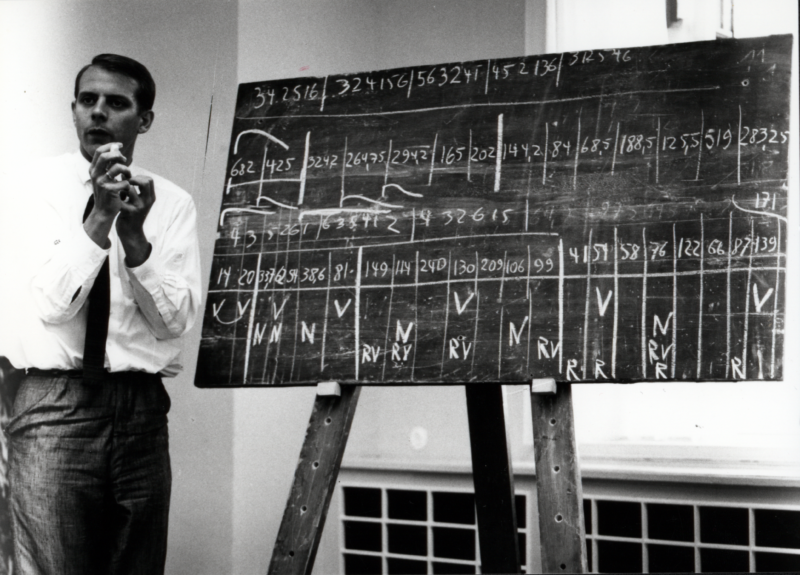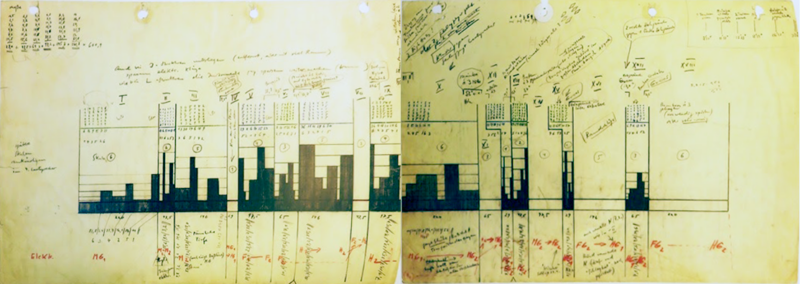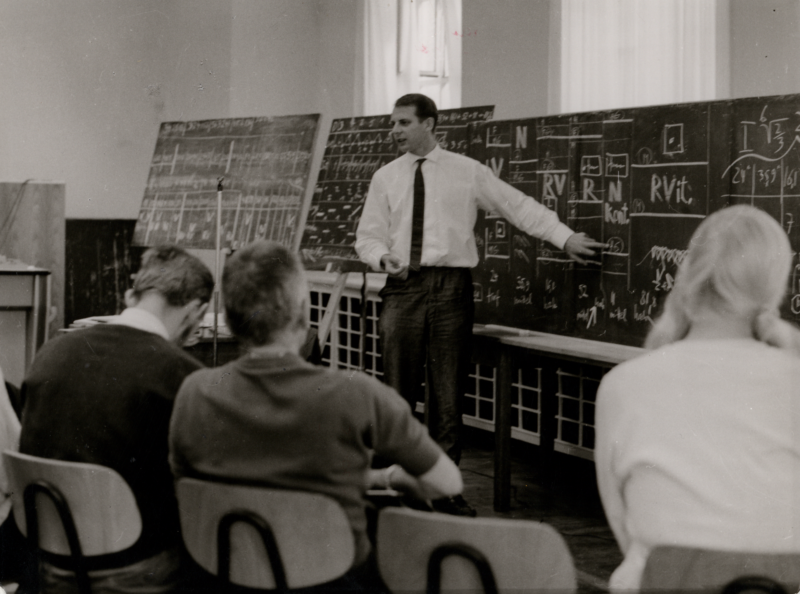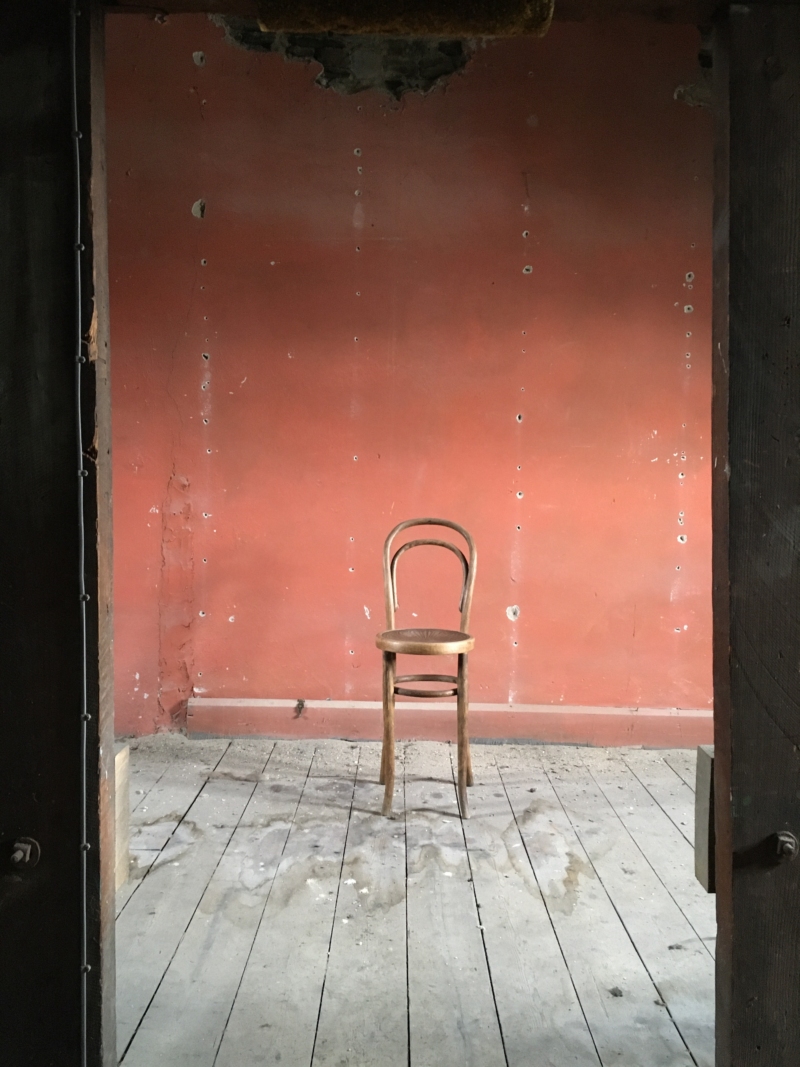READER: KONTAKTE
29. / 30.07.2025

Mi, 30.07., 15+16.30, Bessunger Knabenschule
Karlheinz Stockhausen: Kontakte (1958–60)
for electronic sounds, piano and percussion
GBSR Duo
George Barton (Percussion)
Siwan Rhys (Piano)
Tue, 29.07., 19.30, Lichtenbergschule (Halle)
Angharad Davies: Empty Spaces II (2023)
BREAK
Karlheinz Stockhausen: Kontakte (1958–60)
GBSR Duo
George Barton (Percussion)
Siwan Rhys (Piano)
Kontakte is Stockhausen’s 5th electronically-created tape work, after Etude, Studie I & II, and Gesang der Jünglinge. The composition plan (consisting of about 700 sheets of paper) was written over 6 months from 1958 to 1959. Afterwards, Stockhausen used these copious notes to create (“realize”) this work at the WDR Electronic Music Studio (with the aid of technicians Gottfried-Michael Koenig and Jaap Spek, in between September 1959 and May 1960). The premiere was on May 10 of 1960 at a festival concert for the International Society for Contemporary Music in Cologne.
Kontakte marks Stockhausen’s first “live” electro-acoustic work in the version with accompanying live instrumentalists. In Gesang der Jünglinge, a boy’s voice was used in the assembly of the electronic layers, but in this case, the “concrete” sounds would be “joined” at the moment of performance. Originally planned as an electroacoustic work with 4 live performers playing scores with some aleatoric elements, it was eventually reduced to just tape, piano and percussion, with all of the live parts completely notated out. After this, Stockhausen would move on to apply electronic signal processing to the live instruments (“live electronic music”) in works such as Mikrofonie, Mixtur, Prozession etc… During these years, the tape-only works Telemusik and Hymnen would also be major creations. However, in many ways, Kontakte is Stockhausen’s signature breakthrough work of this period, and possibly his entire oeuvre, which is saying quite a lot, considering the incredible variety and breadth of his 57-year career.
From a compositional standpoint, this work is also the meeting point between 2 of Stockhausen’s favorite devices. In Kontakte, The synthetic sounds have elements of organized serial technique – that is, properties such as pitch, duration, dynamics and timbre are organized using unique distribution sequences. As mentioned in the “4 Criteria”, the sounds were also organized with 42 different scales (with step intervals from 1/30th of a 5th up to an entire 5th), each one assigned to a timbre based on its “noise complexity”. The other major idea presented here is “moment form”, in which a work is divided into short, consecutive sections which have varying amounts of shared characteristics between them, i.e. – the sections do not necessary have to be related to each other in any kind of traditional thematic way. The concept of “moment form” was also featured in the concurrently-composed work, Carré for choir and 4 orchestra groups (though moment form elements were hinted at as early as in Gruppen for 3 orchestras).
The title Kontakte refers to 3 kinds of “contacts”:
- CONTACT Between Sound Families: The acoustic (percussion) and electronic timbres of Kontakte were organized according 3 pairs of pitched and un-pitched sound families:
- Metal
- Tones (crotales, cow bells…)
- Noises (tam tam, gong, cymbals, hi-hat…)
- Wood
- Tones (wood blocks, marimba…)
- Noises (bamboo rattles/claves…)
- Skin (membrane)
- Tones (tom-toms, bongos…)
- Noises (bongos filled with beans…)
- Metal
- CONTACT Between Space Shapes: The use of spatial movement around the listener (and distance from, to a lesser extent) is helpful in adding a dramatic element to serially-organized music, which can tend to have a “flat, pointillistic surface”. The title “Contact” refers to the connections between the spatial shapes created by the sound projection (“Raumgestalten”).
- CONTACT Between Moments: As mentioned earlier, Kontakte is designed as a sequence of independent sections called Moments (usually coinciding with the Structures). Since each of these Moments can be very different, the contact between these blocks of texture/narrative is another way to appreciate the title’s meaning. Each Moment is organized by sound family, proportion of pitch to noise, register and process.


FURTHER READING
Summary of the Lectures with rich image material of the Electronic Studio at WDR. pdf of "Four Criteria of Electronic Music" (English) Detailed overview over "Kontakte" Article by John Rea with a discussion of the main compositional concepts.

EMPTY SPACES II
Empty Spaces II uses samples of Angharad’s violin playing (recorded in empty rooms of a disused building) to allow Siwan to ‘play’ the absent soloist. The violin is used as a jumping-off point for an exploration of absence and a clearing of imaginary space.
Angharad Davies
